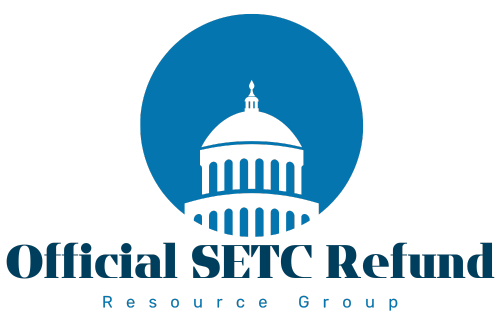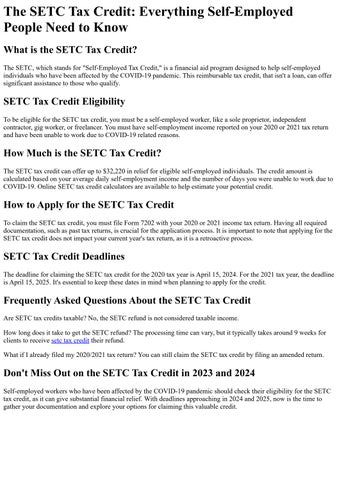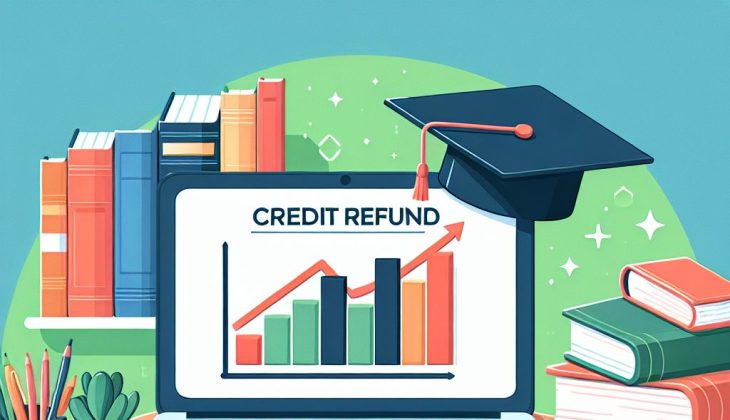Important Points
- Start the SETC refund process by preparing all necessary tax documents, including IRS Form 7202.
- Make sure you meet the eligibility requirements by having positive net income from self-employment for the years 2019, 2020, or 2021.
- Determine your potential credit using the SETC Estimator Tool for precise results.
- Send your application with complete and accurate information to avoid hold-ups.
- Prepare for the refund process to take several weeks; however, mistakes can extend this period.
A Simple Guide to the SETC Refund Process
Securing a refund through the SETC process may appear overwhelming, but it doesn’t have to be. We’ll simplify it into easy steps so you can get your refund without any worries. The SETC, or Self-Employed Tax Credit, is a crucial advantage for many self-employed individuals. It can drastically decrease your tax liability or even lead to a refund. But first, you need to know how to go through the process.

How to Begin Your Refund Process
Start by collecting your paperwork. This should include your tax returns for the years 2019, 2020, and 2021. You should also have IRS Form 7202 on hand, as it is necessary to confirm that you are eligible. Don’t forget to have your driver’s license ready for ID verification.
After you’ve gathered all the necessary paperwork, the next step is to confirm your eligibility. The SETC is intended for individuals who earn income through self-employment. As a result, you must report positive net self-employment income on your IRS Form 1040 Schedule SE for the relevant years.
Documents You Need to Submit
It’s important to submit the correct documents. In addition to your tax returns and Form 7202, make sure that all your information aligns with what the IRS has on file for you. If there are any discrepancies, it could lead to delays or even a denial of your application. Be sure to verify your personal information, like your name, address, and Social Security number.
When to Expect Your Refund
Once you’ve submitted your application, it’s time to wait. Processing refunds can take a few weeks. The IRS usually processes refunds within six to eight weeks, but this can fluctuate depending on their workload and any mistakes in your application. To prevent any unnecessary delays, make sure your application is filled out completely and correctly. For more information on deadlines, you might find it helpful to review the ERTC deadline terms that non-profit organizations must know.
Grasping the SETC Credit Distribution
Grasping the distribution of the SETC credit can assist you in making the most of your benefits. The credit sum is determined by your average daily self-employment earnings and the number of workdays you were unable to work due to COVID-19 effects. This knowledge can help you more accurately predict your refund.
Who is Eligible to Receive Credits?
The first step to receiving the SETC credit is to meet the eligibility criteria. As we have previously stated, it is important to have positive net income from self-employment. In addition, you should have been impacted by COVID-19, either by falling ill or by having to take on caregiving responsibilities, which has disrupted your ability to work.
Keep in mind that if you claim the SETC, it can have an impact on your adjusted gross income and possibly affect other tax credits and deductions. So, it’s important to know your overall tax situation before you apply.
Figuring Out How Much Credit You Could Get
You can use the SETC Estimator Tool to figure out how much credit you might get. The tool looks at whether you’re self-employed, whether COVID has disrupted your work, and whether you might qualify for any family leave tax credits. The more accurate the information you give, the more accurate the estimate of your credit will be.
How SETC Affects Your Income Tax
The SETC credit can greatly lower your income tax. In some cases, it could even lead to a refund. But remember, the credit can change your eligibility for other tax benefits. So, it’s a good idea to talk to a tax professional to fully understand how it affects your taxes.

How to Use the SETC Estimator Tool
The SETC Estimator Tool is a useful tool for anyone who wants to find out how much tax credit they might get. It makes the complicated calculations needed to work out your credit amount much easier. By using it, you can get a better idea of how much you might get back in your refund.
How to Use the Tool
It’s easy to find the SETC Estimator Tool. Just go to the IRS website and look for the self-employed tax credit section. For more insights, you can also explore ERTC changes impacting non-profit clinics. Here’s how to use it:
- Open the “SETC Estimator Tool” by clicking on the link.
- Make sure to read any instructions or guidelines provided on the page.
- Input your self-employment income and any days you were unable to work due to COVID-19.
- Before submitting, double-check your inputs to ensure they are correct.
These steps will allow you to efficiently use the tool and receive an accurate estimate of your tax credit.
Information Required for Precise Calculations
To guarantee the precision of your calculation, you must supply certain information. This comprises:
For an accurate and efficient refund process, be ready with the following details:
- The total amount of income you earned from self-employment in the relevant tax year.
- The total number of workdays you were unable to work due to COVID-19 related reasons.
- Any family leave credits you may have been awarded.
Understanding Your Results and What to Do Next
When you get your estimated credit, it’s crucial to know what it signifies. The tool will provide you with a number that reflects your possible tax credit. This sum can lower your total tax liability or raise your refund. Once you’ve understood the results, the next thing to do is to claim the credit using IRS Form 7202.
Applying to SETC
Once you’ve worked out how much credit you might be eligible for, the next important step is to apply. This means completing the required forms and making sure all the information you provide is correct and complete.
Completing the Application Form Accurately
Completing IRS Form 7202 accurately is crucial to avoid delays. Here’s how you can do it:
- First, you need to download the form from the IRS website.
- Make sure to read the instructions on the form carefully.
- Fill in your personal details, including your Social Security number and self-employment income.
- Provide information about the workdays you missed and any other information that is required.
- Before you submit, double-check all the information you entered to make sure it’s accurate.
Remember, accuracy is important. Even a small mistake can lead to delays in processing or even rejection.
Typical Errors to Steer Clear Of
When you’re filling out the SETC application, there are a few typical errors that can cause problems. Here are the things you need to avoid:
- Personal information that is incorrect or doesn’t match.
- Forgetting to include important paperwork, such as your tax returns.
- Incorrectly calculating your self-employment income or the number of workdays you missed.
By avoiding these errors, you can make the application process go more smoothly and get your refund more quickly. For more information, you can refer to the Self-Employed Tax Credit (SETC) FAQs.
Why You Should Consult a Tax Professional
If you’re not confident about any aspect of the process, it can be helpful to consult a tax professional. They can provide advice on how to fill out forms, how to calculate credits, and how to understand the impact of the SETC on your overall tax situation. A tax professional can also help you avoid common mistakes and make sure your application is submitted correctly.
Common Questions About SETC Refunds and Credits
Trying to understand the SETC refund process can lead to many questions. Here are some common questions to help clear up the process:
Who is eligible for the SETC refund? To be eligible, you must have a positive net income from self-employment and have been affected by COVID-19.
What is the timeframe for processing the refund? The usual processing time is between six and eight weeks, although mistakes can cause delays. To avoid potential setbacks, it’s essential to understand the ERTC eligibility checklist for accurate submissions.
What paperwork do I need to apply? You will need your tax returns, IRS Form 7202, and identification documents such as your driver’s license.
Is there an appeal process if my application gets rejected? Yes, there is an appeal process. However, it is recommended to seek advice from a tax expert to make your appeal stronger.
This information should help you understand the SETC refund process better and get through it more quickly and easily.
Who is eligible for the SETC refund?
In order to be eligible for the SETC refund, there are certain criteria that you need to meet. First, for the years 2019, 2020, or 2021, you must have a positive net income from self-employment. This means that your earnings from self-employment should be greater than your expenses.
In addition, you must have encountered interruptions in your job as a result of COVID-19. This encompasses times when you couldn’t work because you were sick, had to care for others, or for other reasons related to the pandemic. The IRS uses these factors to decide if you qualify for the refund.
Make sure that all the information you provide is correct and matches your tax returns. If there are any discrepancies, your refund application could be delayed or denied. So, check all your details twice before you submit them.
What is the timeline for the refund process?
Generally, the SETC refund process can take anywhere from six to eight weeks. However, this timeline can change depending on a variety of factors, such as the completeness and correctness of your application, as well as the IRS’s current workload. If your application is incomplete or has errors, this could cause further delays.
What paperwork is required for the application?
For the SETC refund application, there are several important documents you need to prepare. These are your tax returns for the years 2019, 2020, and 2021, specifically the IRS Form 1040 Schedule SE. Additionally, you need to fill out the IRS Form 7202, which is crucial for confirming your eligibility. Also, remember to attach a copy of your driver’s license for identity verification.
What if my application is rejected?
Should your SETC refund application be rejected, you are allowed to make an appeal. The first thing you need to do is to understand why it was denied. The IRS usually provides this information in their correspondence with you.
After you’ve determined the reason for your application’s rejection, you can compile any further documentation or proof required to bolster your argument. It may be worth it to seek advice from a tax expert who can assist you in putting together a more compelling appeal and navigating the process.
What is the impact of the credit on my other tax benefits?
When you claim the SETC credit, it can have an effect on your other tax benefits. For example, it can change your adjusted gross income, which is a key determinant for various tax credits and deductions eligibility. So, it’s important to know how the SETC will affect your total tax situation.
Furthermore, the credit can help decrease your taxable income, which could potentially reduce your tax liability. However, it could also disqualify you from certain income-based benefits if not managed correctly. Consulting a tax advisor can provide clarity on how the SETC will impact your specific tax situation.
Let’s take Jane as an example. She’s a freelance graphic designer who claimed the SETC credit. This lowered her taxable income and made her eligible for more health insurance subsidies. However, it also raised her adjusted gross income, which impacted her ability to claim a child tax credit.
Grasping these dynamics can assist you in making educated decisions about claiming the SETC credit.
What if I made a mistake on my application?
If you made a mistake on your SETC application, don’t panic. It’s crucial to fix it as soon as possible. A mistake can cause delays in processing or even cause your refund request to be denied. Contact the IRS as soon as you notice the error.
Usually, the IRS will let you fix your application by giving the right information. But remember, this could make the processing time longer, so it’s really important to make sure everything is correct from the beginning.
Let’s say Tom made a mistake by inputting the incorrect Social Security number on his application. He quickly reached out to the IRS and was able to rectify the mistake. However, this resulted in his refund being delayed for a few weeks.
Double-checking all information before submitting it can prevent these problems from occurring.
Should I hire a tax professional?
Although it’s not necessary to hire a tax professional for the SETC refund process, it can be helpful, especially if you’re not comfortable with tax forms or have a complicated tax situation. A tax professional can provide assistance on filling out forms, figuring out your credit, and comprehending the larger implications of claiming the SETC.
Is there a time limit to claim the SETC refund?
Indeed, there are particular time limits to claim the SETC refund. You usually need to submit your application by the tax filing deadline for the relevant year. If you miss this deadline, you could lose your eligibility for the credit.
Make sure you don’t miss out by marking the deadline on your calendar and preparing all the required documents ahead of time. If you think you might need more time, you might want to think about applying for an extension. This can give you more time to submit your application without being penalized.
Ultimately, getting to grips with the SETC refund process and taking the appropriate steps can help you get the most out of your tax benefits. With careful attention to detail and a thorough approach, you can handle this process with ease and efficiency.
Keep in mind, if you’re ever unsure, speaking with a tax professional can give you the certainty and assurance you need to make sure your application is successful.

